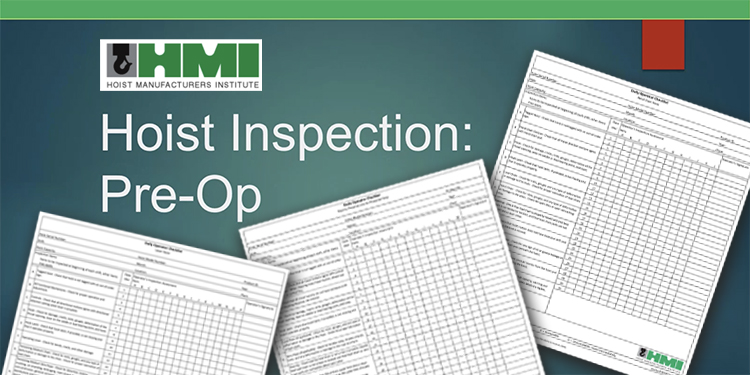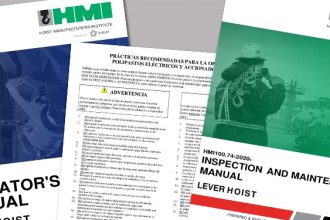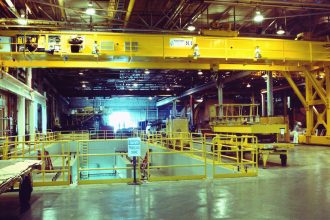Hoist Inspection Webinar, Part 2: Checklist Highlights Key Areas To Evaluate During Pre-Operational Assessments

As discussed in the previous post, the Hoist Manufacturers Institute (HMI) of MHI recently presented the 45-minute webinar “Pre-op/Daily Hoist Inspection: What You Need To Know To Be Safe, Productive and Compliant.” In addition to reviewing the importance of conducting an assessment of hoists prior to operation, the session also offered a detailed walk-through of the key areas to inspect. To help ensure a comprehensive evaluation during these daily pre-operational/pre-shift inspections, HMI has published three separate free checklists, one each for electric powered and air powered hoists, hand chain hoists, and lever hoists. These provide an overview checklist of the key components to review, per hoist type.
The point of the daily pre-operational/pre-shift hoist inspection is to discover any components of the equipment that might be damaged. If any damage is discovered, the hoist should be removed from service and locked-out/tagged-out of use until the problem has been addressed or repaired by a qualified service technician. Therefore, the first checklist item an operator should look at on a hoist is to determine if the device has been deemed unusable during a previous shift and marked with a tag as being out of service.
Next, the overall appearance of the hoist should be considered. Signs of an issue include excessive oil leaks, such as those indicated by a puddle of oil on the floor, by oil running down the load chain, or by oil or grease being present on the load hook. Additionally, all of the operational warning tags — which typically illustrate user “dos and don’ts” — on the labels supplied by the hoist manufacturer should be present, visible and legible.
The control devices associated with the hoist should also be assessed. These include remote or wired pendants or radios. The operator should verify that directional arrows up and down do indeed raise and lower the hook respectively. If the hoist is attached to a trolley that is likewise operated by the same controller, lateral movement forward and backward should also be confirmed to ensure there are no reverse phasing issues.
A thorough inspection of the load hook should then occur. Problematic issues include damage such as cracks, nicks, gouges, deformation of the hook’s throat opening, weld spatters, wear on the saddle (also known as the load bearing point), corrosion, pitting, or twisting. All of these characteristics can negatively impact the hook’s ability to safely hold a suspended load. Likewise, the spring-mounted latch automatically should engage with the hook; if it does not, the hook may have been stretched by a load that exceeded the maximum capacity rating, or the spring may have failed.
If the hoist utilizes a load chain, it should be inspected for gouges, nicks, excessive wear, deformation, rust, or other damage. Further, damage to the chain may also indicate damage to other internal hoist components that are not visible without opening up the housing. For example, chain guides and load sheaves — both of which interact with the chain — may have been damaged as well. An undamaged load chain should also be free of rust, weld spatter or any foreign substance; instead it should be clean and properly lubricated.
Hoists outfitted with wire rope also require an inspection of the wire cabling. The inspection confirms that the wire rope is free of broken strands, abrasions, peening (impact damage or deformation). It should also not have twists, kinks, or other types of damage visible.
When applicable, the function of limit devices that stop the lifting motion of the load block at the upper and lower limits of travel to prevent hoist damage should also be verified prior to connecting a load to the hook. During the operation portion of the inspection, the operator should note any abnormal sounds or unusual vibrations. Likewise, braking function should be assessed to determine that there is no excessive drift or slippage during the first load lift of the day to verify safe operation.
If any issues are noted during the inspection, the hoist should be removed from service immediately. Completed checklists should be collected and kept on file within the facility, as this documentation verifies that the assessments are being performed properly and on schedule, as well as that the equipment is operating both effectively and safely.
In addition to hoist inspection checklists, HMI offers a variety of other technical resources — including a comprehensive library of product guides; a hoist certification program; OSHA Alliance safety tip sheets, fact sheets and quick cards; multiple technical papers and more — via its website at www.MHI.org/hmi.
More details about performing hoist inspections are included in this recent MHI Solutions magazine article. Click to download a free copy of HMI’s Daily Operator Checklists for Hoists (Powered, Hand Chain and Lever Operated).



